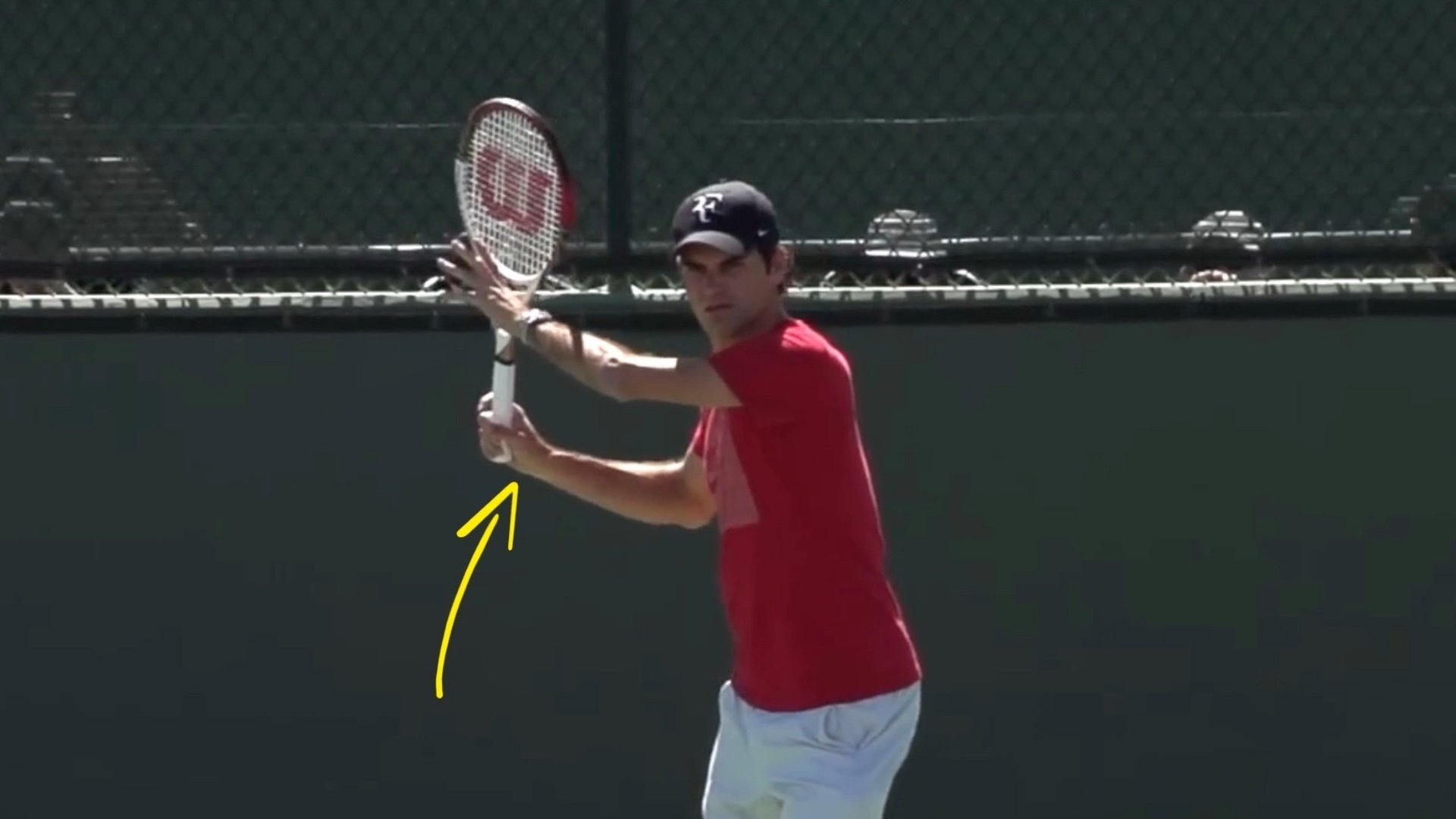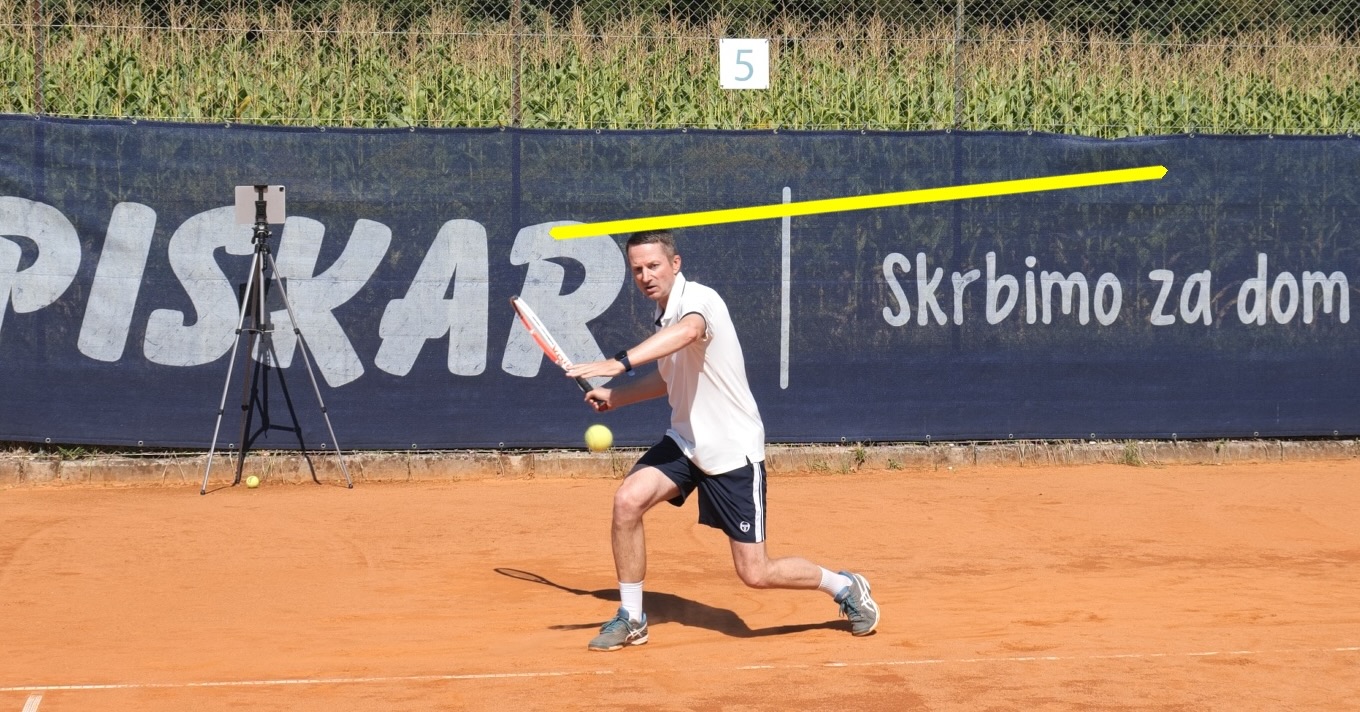The modern game of tennis is often associated with open stance forehands (and backhands) since they allow for more power and take less time to execute.
But that doesn’t mean that neutral stance forehands – or stepping into the ball – are obsolete and that you shouldn’t be using them in your tennis game.
So, when should you use an open stance and when a neutral stance forehand? As you will see, the answer is: “It depends.”
When To Use An Open Stance Forehand
The open stance forehand is best used for:
- fast incoming balls,
- high balls,
- and balls to the side.
1. Dealing with fast balls
An open stance forehand is good for dealing with fast incoming balls because it takes little time to prepare (you simply turn the upper body without moving your feet – or you just make a quick, short shuffle) and because you are not getting closer to the ball which would give you less time.

An open stance forehand will be the most efficient and consistent when receiving a fast ball
If you were to play the same incoming ball with a neutral stance, you would step towards the ball and therefore shorten the distance to it and have less time to execute the stroke.
While sometimes we still step instinctively into a fast incoming ball to get a good weight transfer into the shot, we will always have more time just staying in a open stance.
2. Dealing with high balls
Playing a high ball with your forehand or two-handed backhand is always easier in an open stance than in a neutral stance.
That’s because we swing more across the ball when it’s high and that’s more comfortable if we are in an open stance. Only one-handed backhands where we cannot rotate the body much are still better played in a neutral stance.
I’ve explained already in more detail how to handle high balls, so just follow the link to learn more.
3. Dealing with balls to the side
If we happen to receive a ball to the side and we run towards it and end up in a neutral stance, then the momentum of movement will take us one more step to the side after we hit the ball.
Then we’ll also need one more recovery step to initiate the movement back to the middle.

Playing a wide forehand with a neutral stance will require one more recovery step
But, if we were to play that ball in an open stance (assuming we can reach it with an open stance), then we can resist the momentum and immediately start recovering back to the middle after we hit the ball.
So, we’ll move less and recover faster compared to a neutral stance forehand on a wide ball.
If the ball is too far to reach it with an open stance then you’ll simply have to hit a forehand on the run and recover later.
When To Use A Neutral Stance Forehand
The neutral stance forehand is best used for:
- short balls,
- approach shots,
- and warming up for a session or a match.
1. Playing short balls
A neutral stance forehand is best used on slightly shorter balls when it’s the most natural to step towards them.
If we happen to force an open stance on a short ball, we won’t be able to rotate our body into the shot because that step forward also pushed our hip forward and we have no more body rotation left.

You're have no more hip rotation (and therefore power) if you reach towards a short ball with an open stanbce
And, if we cannot rotate into the shot, then we lose on power.
But, stepping into the ball with the left foot (for righthanders) still allows for hip and body rotation, and that gives us more easy power for the forehand.

If you step into a short ball with a neutral stance you can still use hip rotation and maintain better balance
2. Approaching the net
Hitting an approach shot with an open stance forehand can be done, but transitioning to movement towards the net will always be a bit slow.
You will be much more efficient and quick when you step into a short ball and then naturally move towards the net after the shot.
One exception to this rule might be a really high but short ball which is easier to attack with an open stance forehand.
3. Warming up
I recommend you intentionally play more neutral stance forehands and backhands in the warm-up because that is the most fundamental body movement for any groundstroke in tennis.
It allows us to feel good weight transfer into the ball and relax the arm into a swing that creates effortless power.
Note how Grigor Dimitrov plays most shots in a neutral stance when he is warming up. You can look up other pros like Federer and Djokovic on YouTube and you’ll see the same approach.
That’s especially important if you’re about to play a match since you may be feeling some pressure in the warm-up and your body will have a tendency to tense up.
So, your goal should be to counter that tendency and work towards relaxing your arm. Hitting in neutral stances usually relaxes the arm more than playing in open stances.
Open Or Neutral Stance Forehand?
As you can see, the answer is: “It depends.”
You shouldn’t force yourself into one certain stance just because someone says that’s fashion now.
If you start observing the pros carefully, you will see that they constantly switch between various stances depending on the situation they are in.
There are, of course, more stances besides open and neutral stance (like closed and semi-open), but these two happen most of the time. The variety of stances is often a source of confusion for players since they are not sure which one to use.
You can use any stance you want, just for the record.
You will find the right stance in the game by focusing on comfort and time.
Try to feel which stance feels better in a certain situation. Play a few times in a neutral and a few times in an open stance, and compare which one feels more comfortable.
Also compare which one gives you more time to hit.
As you do this more and more times, you will soon realize which stance works better for a certain situation.
Of course, you can track all this only if you don’t play points.
If you play a match, you’ll be so stressed and so focused on the tactics and possibly your opponent that you will have no awareness of which stance feels better in which situation, even though your mind and body will signal that to you. You just won’t hear it.
The best way to start with stances is to test yourself if you’re actually equally comfortable hitting a neutral and an open stance forehand in very easy conditions – like receiving balls from a ball machine, someone feeding you balls or just in a nice cooperative rally.
In my experience, most players are not equally comfortable in both stances, yet they would need to be comfortable if they want to handle situations on the court well.
So, start with the various drills for stances that I have shown before so that your body and legs especially get used to both open and neutral stance forehands.
Then it will be much easier to find the right stance in terms of comfort and time in a live ball exchange and eventually in real matches.





Great work on letting people decide what stance they should use. On your search section, could you add an “alfred” type system where I would only have to ask one word or one question, and a listing of your videos would come up?
Thanks
Q
Thanks, Q. As for advanced search option, it will depend on the development of this particular wordpress theme.
Hopefully they will implement that in the future.
For 2018 I would like to see more proper footwork movement lessons on the court for less injuries and speed – forehand and backhand and approach. Also serve and volley lessons footwork.
Thanks, Fred, will keep your suggestions in mind.
Tomaz,
This lesson is very helpful since I am 50 (4.0-4.5 player) and learned in the old days of almost all forehands being neutral and swing path back to forward more. About 6 years ago I learned open stance with more heavy topspin up and sideways swing path and rotated my grip a bit.
But a bad habit I have trouble getting over is what to do with my left arm. My left arm and even shoulder tend to squeeze in toward my right at contact instead of moving out of the way and with the body rotation.
If I hit forehands with my left hand in my pocket or behind my back, I get more power and do fine. I’ve tried catching the racket.
But in pressure situations, I still go back to contracting, sort of out of hope of having better directional control I think.
Any clues on what might break me (other than taping down my arm or hypnosis!?)?
Hi Chris,
The left arm simply shows whether you feel the shoulders as one unit or not.
When the shoulders are not connected and you don’t feel the leverage you get by shoulder rotation, then you use the right arm mainly to swing the racket.
When you do that the left arm becomes passive and then it gets in the way of the right arm.
When you rotate the shoulders through the shot then the left arm is active.
I have a whole lesson on shoulder axis and the role of the left arm in my forehand course and a series of drills you can do to start feeling the shoulders.
https://www.feeltennis.net/effortless-forehand/
It’s impossible to explain all that in words here.
You can try this one: just shadow swing with no ball and in the follow-through catch the racket with the left hand and also RELEASE the racket with your right hand. Don’t hold it any more.
Then use the left hand to prepare the racket to the side and that’s when the right hand takes over again.
So you go back and forth like this for 5 minutes per day. There should be some change in 1-2 weeks of practicing that.
Thanks, Tomaz. You seemed to really understand my problem so clearly based on scant information. Of course that shouldn’t surprise me given what I know you know about the nuances of tennis. So I will work on it and look into your course, too. You may solve what pros for years have told me but given few real techniques for overcoming. Will report back. Cheers, Chris
Glad to have helped, Chris, keep in touch!
Tomaz, as always thanks for your tips an lessons.
For us, these advices are very usefull for aply in the day by day or to fixed very old concepts.
My wish is that you will have a great 2018.
Sincerely, Marcelo from Argentina.
Very nice! … Thank you Tomaz … this also clarified how to handle high balls back or short. … One separate question I had (if you do not mind answering) is how to handle cross courts shots. Open or close stance I am very good at down the line shots, but I struggle a lot with cross court balls (short or from base line). My cross courts are high loopy (giving opponent more time) and very less power. With my powerful hard and low down the line shots I build up a point, then get a short week ball which I just cannot put away with a decent cross court shot. Thank you.